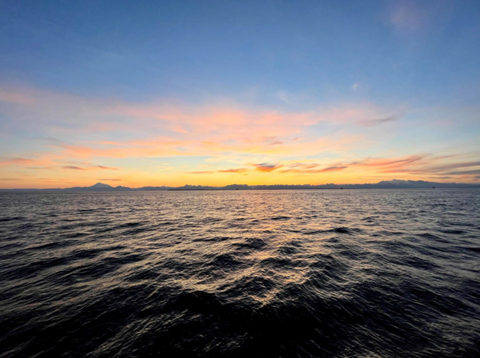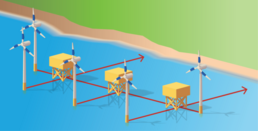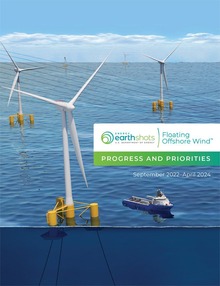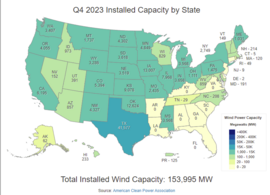|
WINDExchange Newsletter
Issue #229 | May 29, 2024
The WINDExchange Newsletter is a quarterly publication highlighting wind energy resources for decision makers, community members, homeowners, and others from the U.S. Department of Energy (DOE) and its national laboratories. If you have questions, please contact WIND.Exchange@nrel.gov.
|
|
In This Issue
- Workforce Support
-
Offshore Expansion
- New Resources
- Events & Opportunities (including a WINDExchange webinar TOMORROW)
|
|
According to a new national lab report, the demand for workers in the land-based and offshore wind energy industries combined could reach 258,000 by 2030 while the supply of qualified workers might reach only 134,000—a shortfall of approximately 124,000 workers. However, the same report identifies several strategies to close this wind energy workforce gap—strategies which include helping to:
Twelve competing teams and seven learn-along teams of students from across the nation recently gathered in Minneapolis, Minnesota, for the DOE 2024 Collegiate Wind Competition final event. The teams, who represent colleges and universities across the nation, spent the 2023–2024 school year designing and building model wind turbines, creating wind energy project development plans, connecting with members of the wind industry, and raising awareness of wind energy in their communities.

The final event marked the culmination of this work, with the teams presenting their work to panels of wind energy experts and testing their model wind turbines in an onsite wind tunnel. California State University Maritime Academy rose above the 11 other competing teams to claim first place overall, with other university and college teams receiving additional awards and honorary mentions. DOE is accepting applications for the 2025 Collegiate Wind Competition. Apply via HeroX by June 13, 2024.
|
|
|
Offshore Expansion
the Pathways to Commercial Liftoff report, highlighting the rapid progress and potential of the offshore wind sector. The report outlines how the sector is adapting to challenges and is poised to create tens of thousands of new jobs while expanding clean energy access for millions of Americans. The DOE also announced $48 million in funding for offshore wind research and development, supporting technology, domestic manufacturing, and wildlife protection. This initiative supports the Biden-Harris administration's goals of a 100% clean power sector by 2035 and a net-zero emissions economy by 2050.

New findings from the Department of the Interior's Bureau of Ocean Energy Management that Alaskan coastal waters along the Outer Continental Shelf contain a vast potential of 3,800 gigawatts in wind, wave, and tidal energy capacity. However, logistical issues and the need for clean energy transition strategies for the state’s The encouraged ongoing research and recommended a collaborative, science-based, and inclusive approach to stakeholder engagement to ensure equity and accessibility in supporting Alaska's clean energy transition.
|

Curious about how wind crossing the ocean can power American homes on shore? Transmission systems allow cables offshore to connect with the grid. Check these interactive graphics to see what that looks like and learn how the DOE ’s Grid Deployment Office is planning and supporting offshore wind energy transmission on the Atlantic, Pacific, and Gulf coasts, with many benefits, such as improving U.S. grid reliability, adding good-paying jobs to the economy, expanding clean energy, and helping local communities.
|
loating offshore wind energy, especially on the West Coast, is one of many solutions needed to decarbonize the nation’s energy system and combat climate change. Researchers the challenges of floating offshore wind farms—issues like predicting wind speeds, reducing environmental impacts, and connecting wind energy into the power grid. For instance, in one project, researchers are using buoys to gather atmospheric and oceanographic data to enhance wind forecasts at turbine heights. In another, they are studying how humpback whales might interact with floating offshore wind installations. Efforts like these are key to unlocking the potential of floating offshore wind energy.

The U.S. departments of Energy, the Interior, Commerce, and Transportation released a report highlighting progress on the Floating Offshore Wind Shot™ initiative. The report shows that, since the initiative’s September 2022 launch, the Biden-Harris administration has allocated over $950 million toward planning, leasing, research, and development to harness floating offshore wind energy. Key achievements include a $426.7 million investment from the U.S. Department of Transportation in the first offshore wind terminal on the Pacific Coast and the announcement of the FLoating Offshore Wind ReadINess Prize Phase Two winners.
|
|
|
|
Unlock Onsite Energy Solutions With the National Distributed Wind Network and Distributed Wind Energy Resource Hub
Are you thinking of using distributed wind energy to support electricity needs at your home, farm ranch, or business?

Two new resources can help you decide. The National Distributed Wind Network provides expert support for people considering distributed wind energy technologies for onsite and local power needs, while the WINDExchange’s Distributed Wind Energy Resource Hub offers a curated directory of basic information, project funding, technical assistance, case studies, and tools to determine whether a distributed wind energy installation is right for your
|
Navigate Wind Energy Ordinances With New WINDExchange Database
can wind energy projects be located? What are the requirements for obtaining permits and licenses for wind energy projects? How far must wind turbines be set back from property lines, roads, homes, and other structures? These are the kinds of questions wind energy ordinances can help answer. Wind energy ordinances, which regulate aspects of wind projects like location, the permitting process, land use, noise standards, and safety, are one of the best ways for local governments to identify conditions and priorities for all types of wind energy development. Explore WINDExchange’s new wind energy ordinances database to find U.S. wind energy ordinances at the state and local levels!
WINDExchange Map Illuminates U.S. Installed and Potential Wind Power Capacity

Wondering how much wind energy is already installed across the United States? Check out our U.S. wind power capacity map, newly updated to reflect installed wind power capacity as of the end of 2023! Then explore our entire collection of wind energy maps & data, which now includes 100-meter land-based wind resource maps for all contiguous states and several 100-meter offshore wind resource maps.
|
Wind Resource Database Serves Up Over a Petabyte of Detailed Wind Data
The Wind Resource Database is a new online platform that provides public access to vast data on the atmospheric forces that affect wind turbine performance, inform wind power plant development, and enhance energy capture. The resource offers more than a petabyte of detailed wind data covering the United States and other countries. Designed for a diverse audience, the platform provides a user-friendly experience with interactive maps and simplified data retrieval—all at no cost.
White House Outlines Resources for Offshore Wind Energy Deployment
The Biden-Harris administration aims to build a U.S. offshore wind energy industry that will power millions of homes with clean electricity, create thousands of well-paid jobs, and enhance energy security while cutting climate pollution. The administration has released a fact sheet that describes federal resources to support the expansion of the U.S. offshore wind energy industry, including tax incentives, infrastructure development, and support for offshore wind research and innovation.
|
|
|
WINDExchange Webinar: TOMORROW, May 30, 2024, 1–2 p.m. ET
Join experts to learn about key concepts in end-of-service processes for wind energy technologies and infrastructure, including decommissioning, repowering, and recycling. Register to join this virtual WINDExchange webinar even if you can’t make it; we will share the recording with all who sign up to attend.
Webinar: June 17, 2024, 1–2 p.m. ET
To help agricultural producers and rural small business owners invest in distributed wind energy, loan and grant awards are available through the U.S. Department of Agriculture Rural Energy for America Program (REAP). for a virtual 90-minute webinar designed to help rural small businesses prepare successful REAP applications. The webinar will feature a discussion of REAP funding opportunities for rural small businesses and cooperatives, an overview of how distributed wind energy technologies can best contribute to rural businesses, tips for submitting a successful REAP application, and a Q&A session—so bring your questions for the experts!
The request seeks input from the wind industry, academia, research laboratories, government agencies, and other stakeholders on challenges, innovation needs, workforce development, and the impact of recent tax incentives. Responses will help shape strategies to enhance domestic manufacturing capacity, reduce import reliance, and strengthen the U.S. supply chain. Submit your response by 5 p.m. ET on July 30, 2024.
|
|
|
|
|